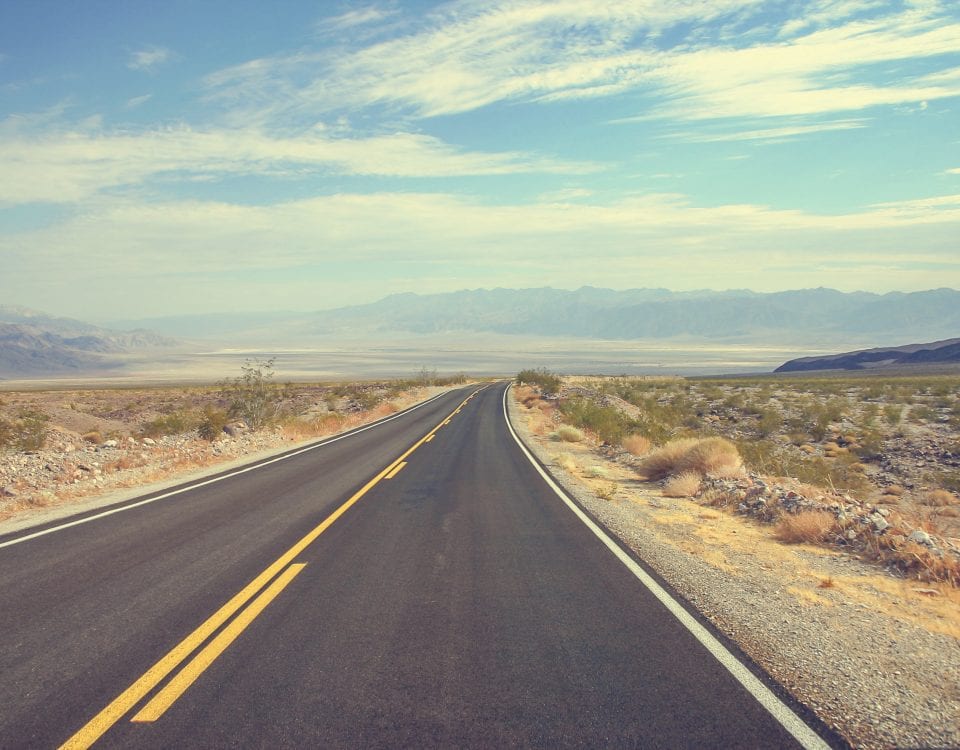
Day 7: Peaches, Flowers and a River Walk
March 26, 2021
Day 5: All Along the Border
March 24, 2021Most recently updated on March 6, 2024
Driven on March 26-27, 2022
Originally posted on March 25, 2021
Texas is one big state. Exactly how big?
For starters, Texas is the second largest state in the United States, behind only Alaska.
Its 268,000 square miles also makes it the biggest state in the continental United States, well ahead of California’s 163,000 square miles.
The state is 773 miles west to east and 801 miles north to south at its widest points.
That means it takes more than 11 hours to drive across the Lone Star State from the New Mexico border to the Louisiana border.
It takes about the same amount of time to drive from Amarillo in the Texas Panhandle to Brownsville at the state’s tip along the Gulf of Mexico.
Texas is so large that El Paso is actually closer to San Diego than it is to Houston. And Amarillo is closer to Cheyenne, Wyoming, than it is to Laredo.
Texas’ population matches its acreage.
Its 30 million residents make it the second most populous state, behind only California. Texas has five of the top 12 most populous cities in the country with Houston leading the way in fourth place with 2.3 million people.
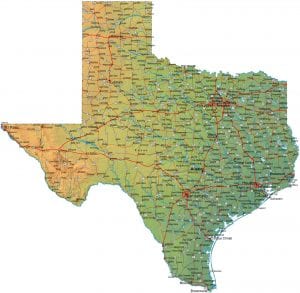
The state’s population is listed as 40 percent white and 40 percent Hispanic or Latino, one of the highest of any state. Another 13 percent is listed as Black with 5 percent Asian.
The landscape of Texas is more diverse than you might think. Only about 12 percent is desert. The rest is mountains, forests, prairies, grasslands, swamps and coastline.
The mean elevation of Texas is 1,700 feet, placing it 18th in the nation. El Paso, for example, sits at an altitude of 3,740 feet.
Texas also has a median age at slightly less than 35 years, the third youngest among the states.
In its early history Texas was inhabited by Paleo-Indians who hunted mammoths beginning 10,000 years ago. It was ruled by France and Spain after 1500 before Mexico laid claim to the land. That reign lasted until 1836 when Texas became an independent republic sitting between the United States and Mexico. It was admitted as a U.S. state in 1845.
At first, cattle and beef were the main industry. Then, cotton farming took hold. However, the state really exploded in 1901 when oil was discovered at Spindletop, a community near Beaumont on the Gulf Coast. Oil rigs began popping up everywhere.
Today, Texas leads all states in oil production. Its 1.8 billion barrels per year is more than the next nine states combined. Texas is also first in natural gas, producing 24 percent of the nation’s supply, ahead of Pennsylvania’s 21 percent. We’ll see plenty of evidence of Texas’ oil power on our drive today.
All that fossil fuel does exact a price. Texas emits more carbon dioxide by far than any state, well ahead of second place California.
Ironically, Texas is also number one in wind power. Three of the top 10 largest wind farms in the world are located here. We’ll see some of that emerging clean energy industry before the sun sets today, too.
Texas is also the only state with its own self-contained power grid. That means it controls its electricity-producing facilities and doesn’t rely on another state. That independence is a source of pride in the Lone Star State, but it exacted a price in February 2021.
Starting on February 13, Texas experienced its coldest weather since 1989. That not only sent demand for electricity skyrocketing, it also chilled natural gas wells, blocked pipes and froze wind turbines and coal piles. The biggest problem was the disruption in the distribution of natural gas, the state’s number one energy source.
All that reduced the amount of electricity the state’s power grid could produce at a time when the demand was exploding. And Texas had nowhere else to turn for help.
Officials at the Electric Reliability Council of Texas (ErCOT), which oversees the state’s power grid, said their system came within minutes, if not seconds, of a statewide blackout. To avoid that scenario, ErCOT implemented rolling blackouts in different parts of the state to keep demand under control.
However, some areas ended up without power for days due to damaged equipment, the need to restore electricity to some areas manually and other reasons.
There were some changes made to the power grid’s infrastructure and emergency plans, but in November 2021 officials still expressed concerns there could be another meltdown if Texas suffers another frigid cold snap. In May 2022, the power grid leaders assured the public there would be enough electricity to meet the expected demand during the hot summer months. Indeed, the state avoided blackouts during summer 2022 despite having 11 days of record energy demand. The system also withstood a heat wave in July 2023 as well as another hot month in August 2023. Proponents of solar energy say part of the credit goes to the increased use of that alternative power source in Texas. In October 2023, ErCOT officials asked utilities to consider restarting some shuttered power plants to boost electricity during the cold winter months, but none of the utilities agreed to do so. There are plans to connect Texas’ power grid to the country’s southeastern power grid, but the transmission lines won’t be operational until 2029.
Energy is not the only strong component of the Texas economy.
The high-tech industry is growing with companies such as Dell, Texas Instruments and Compaq making their home here.
Texas also has 230,000 farms as well as 125 million acres devoted to agriculture. Those are both more than any other state. The average size farm in Texas is 544 acres. More than $32 billion in agricultural products are sold in Texas every year.
The Lone Star State also ranks first in cattle, cotton, hay, sheep and goat production.
In addition, Texas is first in cement production as well as in the manufacturing of chemical products such as fertilizer. There is also a large commercial fishing industry thanks to the Gulf of Mexico.
A lot to digest on Day 6, so let’s get going.
——————————————–
We motor out of El Paso on Interstate 10 to begin today’s journey, zipping past the border towns we visited yesterday.
We’ll be on this freeway for more than two hours before we veer off into north-central Texas.
Interstate 10 is the southernmost cross country freeway in the United States. It’s only one of three that travels from the Pacific coast to the Atlantic coast. The other two are Interstate 80 and Interstate 90.
I-10 begins at the beach in Santa Monica, California, and takes a pretty straight route all the way to Jacksonville, Florida, traveling through eight states along the way.
It is the fourth longest interstate in the country at 2,460 miles. One-third of that mileage is eaten up by Texas, where the freeway crosses the Lone Star State at its widest point.
More than an hour and a half into our drive, we cross from the Mountain Time Zone to the Central Time Zone and coast into Van Horn. The community of nearly 2,000 people is actually the westernmost incorporated city in Texas, and perhaps the country, on Central Time.
Van Horn has been around since the 1850s when the town was established along the San Antonio-El Paso Overland Mail Route. The arrival of the Texas and Pacific Railway in 1881 helped spur a little growth, but Van Horn has existed pretty quietly since then.
The city is probably best known as a stopping point along one of the popular routes to Carlsbad Caverns National Park an hour and a half away in New Mexico. It’s estimated that 10,000 vehicles pass through Van Horn on a daily basis on their way to the caverns and other destinations.
However, what places Van Horn on our map today is healthcare services.
Until 2019, Dr. John Garner of Van Horn was the only physician in this 11,000-square-mile area of Texas, seeing patients in the only hospital within 100 miles. His coverage area was about the size of Maryland.
Van Horn is not the only rural location in the country lacking proper medical services.
The Washington Post noted in 2019 that an estimated 80 percent of rural America was “medically underserved.” Rural areas account for 20 percent for the nation’s population but only 10 percent of the doctors. By the end of this decade, the number of rural doctors is expected to decline by 23 percent.
A January 2023 report stated that 631 rural hospitals were at risk of closing in the next year. The report added that in 12 states 40 percent or more of rural hospitals were at risk.
A February 2024 report noted that half of rural hospitals had lost money the previous year. It stated that 418 rural hospitals were now in danger of closing.
Rural communities are also being affected by a lack of drug stores. A November 2021 Kaiser Health News report stated that more than 1,200 pharmacies have closed in rural areas since 2003, leaving 630 communities without a drug stores.
In November 2023, the Biden administration did announce plans to bolster rural healthcare through the Affordable Care Act and other programs, but it will take time to rebuild this infrastructure.
This lack of services has its consequences.
A 2019 report by the U.S. Centers for Disease Control and Prevention (CDC) stated that people living in rural areas face a higher risk than their urban counterparts of dying from heart disease, cancer, stroke, lower respiratory illness and unintentional injuries.
Part of the reason for the higher mortality rates in general is personal health. People who live in rural areas are more likely to smoke and drink alcohol as well as be overweight and have more limited access to healthy foods.
Combining that with a lack of quality medical care is a worrisome recipe.
The sparsely populated regions of Texas are prime examples of such underserved communities.
The Post report stated that more than half of Texas’ 254 counties had no general surgeon and 121 counties had no medical specialists. In addition, 35 Texas counties had no doctor at all.
Things may not get better any time soon either. Rural physicians are older than their urban counterparts. Half of rural doctors are over the age of 50 and more than a quarter are older than 60.
Garber, now in his 70s, checks these boxes.
The good doctor has practiced rural medicine for more than 45 years. He told the Post he came to Van Horn more than a decade ago for better pay as well as an adventure at the end of his career. He also said he felt his work was more essential here than it would be in other places.
Garber’s load was eased in 2019 when Dr. David Cummings, a 43-year-old medical school graduate from Nevada, was hired by Culberson Hospital in Van Horn.
Cummings was one of only 2 percent of med grads that year who wanted to practice in rural areas. For that reason, he was the subject of an intense bidding war between small town medical centers. Culberson finally grabbed him by offering a three-year contract that began with an annual salary of $300,000, about 50 percent more than Cummings would have earned in a larger city.
Van Horn was in the news in July 2021 when Amazon founder Jeff Bezos and three other cosmic travelers rocketed into the fringes of outer space in Bezos’ Blue Origin spacecraft. The capsule soared 60 miles above Earth and safely landed in a remote area near Van Horn. Bezos’ space research and exploration base is in a facility 25 miles north of the small town. The July 2021 mission brought some tourism to Van Horn and local officials hope that future launches will do the same.
The spotlight shined on this region again in October 2021 when William Shatner, the 90-year-old actor best known for portraying Captain James T. Kirk on the “Star Trek” television show, joined three other crew members aboard another Blue Origin flight into space. People gathered at the launch site in the early morning hours to watch the historic 10-minute flight.
In August 2022, Blue Origin completed its sixth successful space mission, a 10-minute flight. The passenger list included Dude Perfect co-founder Coby Cotton as well as the first Egyptian and the first person of Portuguese descent to fly into space.
Perusing the Permian Basin
We stay on Interstate 10 for another half-hour before we jump on Interstate 20 and head in a northeasterly direction.
We are now driving into the heart of the Permian Basin, an area of western Texas and southern New Mexico that is 250 miles wide and 300 miles long. A total of 75,000 square miles.
There are more than 7,000 oil and natural gas fields here. The basin accounts for about 40 percent of the oil production in the United States and about 15 percent of the country’s natural gas output. The basin is partly responsible for the United States now being the world’s largest producer of crude oil with more than 20 percent of the global share of production.
These fields have been providing oil since the 1920s, but production has ramped up in recent years. The basin’s output reached an average of more than 5 million barrels per day in late 2020, surpassing even the famed Ghawar field in Saudi Arabia. In March 2024, the average had surpassed 6 million barrels per day.
Since 2019, oil rigs have been quickly erected and camps have seemed to pop up almost overnight to house oil industry workers who were earning six-figure salaries.
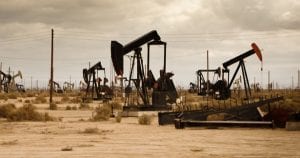
The Permian Basin in west Texas accounts for more than one-third of U.S. oil production. Photo from Tank Transport Trader.
There’s plenty more oil left in the Permian sedimentary basin, too. An estimate in 2020 stated that there may still be at least 20 billion barrels of petroleum crude underground in addition to the 30 billion barrels that have been recovered since the fields opened 100 years ago.
During the recent boom years, the expanding oil industry helped beef up the economy and raise tax revenues all along the I-20 corridor.
All this production did increase air pollution through much of western Texas. It also intensified the debate over the nation’s dependence on oil and its effects on climate change. Some local residents said crime and drug abuse had increased due to the makeshift housing camps. Others complained their once rural roads were being overrun with trucks and tankers.
In reaction, oil companies in 2018 pledged $100 million to improve the infrastructure in the towns of the Permian Basin. During our drive in March 2022, there were considerable highway and roadway repairs under way, but it was also apparent a lot still needs to be done.
As you drive along I-20 east, you can tell you’re in the Permian Basin. The grasshopper-like oil rigs become more common as you go and the smell of petroleum becomes stronger. The haze from air pollution is also evident.
It does make one wonder what will happen to this region if alternative energy sources do become dominant in the next decade or two.
————————-
Our first stop in the basin is the town of Pecos.
The community of 13,000 people sits on the west bank of the Pecos River at the edge of the Chihuahuan Desert.
It was a hot spot in the 1870s when cattle drives crossed the Pecos River here. A train depot built in 1881 added to its growth.
Agriculture has been a mainstay of the economy with cotton, onions and cantaloupes.
The cantaloupes, in fact, were the most famous crop in Pecos for quite a while. There were grown in gardens in the 1880s and reportedly had a distinct flavor.
The Todd family grew their melons on 8 acres of land. Their Sweet Pecos cantaloupes were served on train cars and developed quite a reputation.
Other families began cultivating them, too. At one point, there were 2,000 acres of cantaloupes planted annually in Pecos.
That number, however, has dwindled considerably as the cost of water rose and the lure of oil money beckoned. There’s now only one family farm left in the Pecos area that plants cantaloupes.
The local economy today is driven by agriculture, ranching and, of course, oil and natural gas.
Pecos does have one claim to fame, although it’s disputed. City officials say the town held the world’s first rodeo on July 4, 1883. Several other towns across the United States say they actually had rodeos before then.
Nonetheless, Pecos is home to the Texas Rodeo Hall of Fame, located in the old train depot. It contains exhibits on bronco busters, calf ropers and barrel rollers, among others. There’s also a West of the Pecos Museum that details the history of the town, which actually was east of the Pecos at one time.
——————————
We hop back onto Interstate 20 east and in an hour we arrive in Odessa.
It’s a town some people might know from the book “Friday Night Lights” and the movie and television series of the same name that detailed the 1988 football season at Permian High School as well as the spectacle of high school sports in west Texas.
Perhaps the only thing bigger in Odessa than high school football is oil.
The town was founded in 1881 as a water stop and cattle shipping point on the Texas and Pacific Railway. It may have obtained its name from railroad workers who thought the area reminded of them of their hometown of Odessa, Russia.
The community plodded along until oil was discovered in 1926. Odessa quickly grew from 750 people in 1925 to 5,000 residents in 1929. During that year, more petroleum was unearthed in Penn Field and in 1930 another large deposit was uncovered at Cowden Field.
In World War Two, the demand for oil grew as did the chemical industry. Odessa expanded to 10,000 residents and developed into the world’s largest inland petrochemical center. In 1957, the Odessa Petrochemical Complex became the nation’s first privately funded, fully integrated plant for synthetic rubber manufacturing, using waste products from oil and natural gas to make rubber.
Today, the city has expanded to 114,000 residents, a population that is listed as 62 percent Hispanic or Latino.
The biggest industries in town remain petroleum processing and oil field supplies.
The oil industry here has followed a “boom and bust” cycle every decade since the 1920s.
For the past two decades, Odessa has tried to diversify its economy. The city has become a logistics and distribution center for companies such as Family Dollar and Coca Cola.
There’s also the Notrees Windpower complex owned by Duke Energy outside of town that began operations in 2009 now with 55 turbines producing 90,000 kilowatts of power.
A new solar energy plant owned by Occidental opened on 120 acres near Odessa in 2019. Its 174,000 photovoltaic panels can generate 16 megawatts of electricity. It will be primarily used to power Occidental’s oil and gas operations.
In August 2020, a 500-megawatt solar energy plant also opened in the region. The Enel Green Power facility will provide power to companies such as Clorox and Mondelez. The plant is the largest solar project right now in Texas.
The two sites are among a number of new solar energy facilities being built in sunny Texas, most of them in the Permian Basin.
In April 2023, construction began on what will be the world’s largest direct air capture plant. The 65-acre facility, owned by Occidental, is expected to open in 2025. The $1 billion complex about 35 miles west of Odessa will be capable of capturing 500,000 metric tons of carbon dioxide per year and converting it to low carbon products or storing it underground.
Our first stop in downtown Odessa is the Ben Jack Rabbit statue at 8th Street and Sam Houston Avenue. The 8-foot monument was built in 1962 to commemorate a rabbit roping event that took place during the Odessa Rodeo in 1932 and 1933. The competition was revived in 1977, but it was cancelled in 1978 after the Humane Society obtained a court order to permanently stop the event on the grounds it was cruel to the hares that were being lassoed.
A little farther east is the University of Texas Permian Basin campus. The college has a Stonehenge replica that was built in six weeks in 2004 by stoneworkers Connie and Brenda Edwards. It consists of 19-foot-tall limestone slabs that weigh 20 tons each. It’s designed to be a teaching tool as well as a tourist attraction.
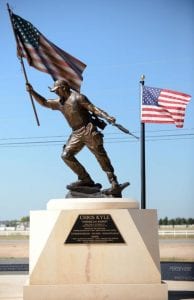
The memorial plaza for Chris Kyle, known as the “American Sniper,” in Odessa, Texas. Photo from the Odessa America
On the way out of town, you can stop by the Chris Kyle Memorial Plaza.
This 2,800-square-foot site was unveiled in 2016 as a remembrance to Kyle, who was born in Odessa in 1974 and was killed by a former Marine he was trying to help at a gun range in 2013. Kyle’s life story was told in the 2014 movie, “American Sniper,” starring Bradley Cooper.
The plaza contains a bronze statue of Kyle as well as memorial walls of polished black granite.
————————————
We exit the plaza on Highway 191, renamed the Chris Kyle Memorial Highway, on our way back to Interstate 20.
We’re only on the freeway for a half-hour when we see the skyline of our next destination.
Midland is nicknamed “Tall City” because of the skyscrapers you can see from the flatlands as you approach. The image goes along with the city’s motto of “The Sky’s the Limit.”
Like Odessa, Midland was founded in 1881 on the Texas and Pacific Railroad line. It was designated as the midpoint between El Paso and Fort Worth. That, in fact, is the origin of the town’s name.
Midland quickly developed into one of the most important cattle shipping centers in Texas.
In 1923, its future changed when oil was discovered in two nearby locales. The city developed into the administrative center of the west Texas oil industry. By 1929, there were 36 oil companies with offices in town. By 1950, that had grown to 215 companies.
After World War Two, the Spraberry oil field was discovered. It’s an area that is still active today and remains the third largest field in terms of oil reserves in the United States.
Like Odessa, Midland has gone through the boom and bust cycles of being an oil town. Demand was high in the 1920s and then declined in the 1930s. It rose again during World War Two in the 1940s and through the 1950s. There was a decline in the 1960s, but then another boom during the Arab oil embargo of the 1970s.
In recent years, Midland and Odessa have benefitted from an increase in oil being extracted from shale deposits. This higher quality oil is found between layers of shale rock. The rock must be fractured to get to the oil, a process known as fracking. Shale oil accounts for about a third of onshore oil production in the continental United States. This type of oil has helped the United States become energy independent, but it also has raised a number of environmental concerns, not the least of which are potential contamination of drinking water as well as the possibility of increased earthquake activity.
The oil boom that accompanied the fracking had sparked Midland’s economy.
The median annual household income in this city of 140,000 people now sits at $71,000 with a poverty rate around 14 percent.
The city pays homage to the oil industry at the Permian Basin Petroleum Museum. The 40,000-square-foot facility has exhibits that include the science behind the 230 million years of oil formation as well as the history of oil exploration in western Texas.
Midland also has a cattle industry that helps drive the economy. It sits at the hub of a 12-county ranching area known for its Hereford cattle.
In addition, it has a telecommunications sector as well as product distribution centers.
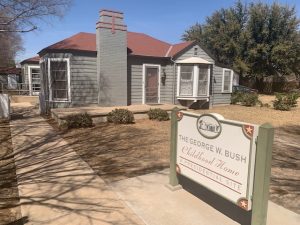
The George W. Bush Childhood Home in Midland, Texas
Before we leave town, there are two houses in Midland worth noting.
One is the George W. Bush Childhood Home on Ohio Avenue. The 1,400-square-foot house was built in 1939. Former President George H. W. Bush and his wife, Barbara, relocated to Midland in 1948 when Bush first went to work in the oil industry. They moved into the Ohio Avenue home in 1951. Former President George W. Bush lived there from the time he was 5 until he was 9. The home today is virtually unchanged from how it was in 1956.
We visited the small, modest home during our March 2022 road trip. The well-kept, freshly painted house is just a few blocks from Midland High School. The front room contains furniture from the 1950s and the kitchen and bedrooms are also mocked up to represent that era.
Jaclyn Woolf, who provides information and tours of the home, told 60 Days USA the residence is the only house where two presidents (George H.W. and George W.), two governors (George W. and Jeb) and a first lady (Barbara) lived.
Woolf said visitors include people from Midland as well as out-of-towners who are making a stop during a road trip. She said important history lessons can be learned here.
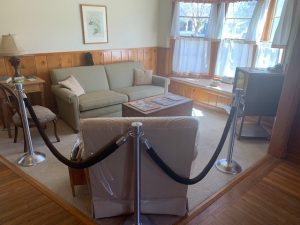
The front room in George W. Bush’s childhood home in Midland, Texas
“People can see the humble beginnings of the Bush family,” she said.
The other well-known house in Midland is a nondescript residence in the Permian Estates subdivision.
What happened to an 18-month-old old girl there on Oct. 14, 1987, gripped the nation for almost three days.
Jessica McClure was playing with four other children in the back yard of her aunt’s home where her aunt and mother operated a daycare operation. Somehow, Jessica fell headfirst into an 8-inch-wide open pipe and ended up 22 feet underground.
A crew of 16 rescuers worked nonstop to free the little girl, finally lifting her from the narrow hole 58 hours after she fell in.
CNN, the only 24-hour news network at the time, covered the event live from start to finish. It was only the network’s second “wall to wall” coverage of an ongoing event. The first was the Challenger space shuttle explosion in 1986. Media analysts credit the “Baby Jessica rescue” with helping usher in our country’s 24-hour news cycle.
Jessica Morales is now 38 years old. She’s married with two children. She worked for a while as an assistant to a special education teacher in Midland but now is a stay-at-home mom. She lives two miles from her aunt’s old house.
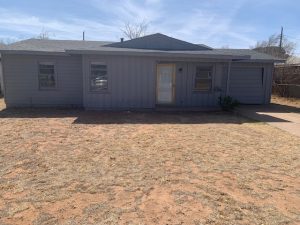
The home in Midland, Texas, where “Baby Jessica McClure” was rescued from a narrow well opening in 1987
In 2011 when she turned 25, Jessica collected $800,000 from a trust fund set up by donations after the rescue. She used the money to buy her family’s current home, purchase two new cars and help her father start a tractor rental business.
Jessica has no memory of the 1987 event, but she does bear a faint scar on her forehead from her face rubbing against the interior of the pipe during her rescue.
Her parents, Chip McClure, who was 18 at the time of the rescue, and Reba “Cissy” Gayle, who was 17 at the time, divorced less than three years after the incident. They both remarried.
There is a plaque at the Midland Civic Center in recognition of the 1987 rescue.
The home in Permian Estates is still there. So is the well. But it now has a cap on top with an inscription that reads “For Jessica 10-16-87 With Love From All of Us.”
We paid a visit in March 2022. The home was for sale and unoccupied at the time. The small house has probably seen better days, but it’s not run down either. A neighbor walked us into the back yard where the small well opening with its cement cap sits in a corner of a small back yard.
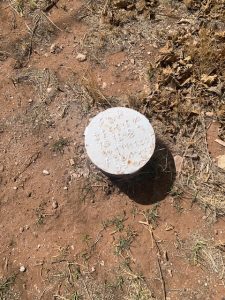
The now-capped well that “Baby Jessica” fell into in 1987.
A real estate flier out front lauded the home’s value, although it didn’t list a price. And, yes, it does mention that this residence is “Baby Jessica’s house.” When you stand there, it’s difficult to believe this was the place where swarms on television trucks, crews and cameras descended in October 1987.
Heading Into the Wind
As we continue northeast on Interstate 20, we start to see the transition.
Oil rigs still dot the landscape but so do tall windmills with blades slowly circulating.
We’re starting to enter one of the prime areas for Texas wind energy.
The Lone Star State produces 40,000 megawatts of wind power generated by more than 15,000 turbines. That’s number one in the country. Wind energy supplies Texas with 28 percent of its energy generation, second only to the 41 percent supplied by natural gas.
The wind energy industry in Texas started to grow in the early 2000s under then-Governor Rick Perry. The state invested $7 billion to create a transmission system to bring renewable energy to Texas cities. The state also has fewer regulations and more tax incentives for the wind industry. During Perry’s tenure, the state’s wind power surged from 116 megawatts to 11,000 megawatts.
The industry now supports 26,000 jobs in Texas with an average annual wage of nearly $110,000.
About 40 minutes out of Midland, we cruise past the town of Big Spring.
This community of 24,000 has been utilizing wind power since the first turbines were installed in 1999. The blades are still churning here on 42 turbines that produce 27 megawatts of power.
The town got its start by taking advantage of another natural resource.
The spring the community is named after was a watering hole for prehistoric animals such as mastodons and saber-toothed tigers.
Native American tribes settled near the spring in later centuries before Spanish explorers passed through. The region was an important trade center for the Comanche. A U.S. expedition checked out the area in 1849 and marked it as a campsite for the Overland Trail to California.
The settlement grew in the 1870s to support the region’s buffalo hunters. Cattle ranching caught on in the 1880s as did cotton farming. The railroad brought in more settlers in the late 1800s.
Oil was discovered here in 1926. By 1936, there were more than 800 working wells in the area. Oil production peaked in the 1950s, although it is still a big part of the local economy.
The military was also a large employer after World War Two. Webb Air Force Base was activated in 1951 and served as a pilot training center. It was an integral part of the town until it was decommissioned in 1977. The property is now a large industrial park.
Big Spring also is home to a low security federal prison as well as a state mental health hospital and a regional Veterans Administration medical center.
The opening scene of the 1969 Oscar winning film “Midnight Cowboy” was shot here as was the 1980 science fiction flick “Hangar 18.”
All the city’s history is captured at the Heritage Museum of Big Spring, which opened in 1970. The museum features one of the world’s largest collection of steer longhorns, in case you’re interested.
—————————-
Another hour east on Interstate 20 and we’re approaching the community of Roscoe.
In the distance just south of town, you can see the turbines of the Roscoe Wind Farm.
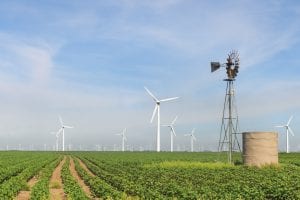
The Roscoe Wind Farm in Texas is the sixth largest wind power facility in the world.
The facility, which has been operating since 2009, has 627 turbines that generate 781 megawatts of electricity, enough for 265,000 homes.
The turbines range in height from 350 feet to 415 feet and are installed 900 feet apart.
The windmills are scattered across 100,000 acres in the midst of cotton fields that overlap into three counties. The landowners earn up to $1,000 per windmill per year.
The $1 billion facility used to be the largest wind farm on the planet. It’s now the sixth largest in the world and the third largest in the United States.
Like Midland, Odessa and other towns along our route today, Roscoe germinated from the laying of the Texas and Pacific Railroad tracks in the early 1880s. In 1894, a cattle pen was relocated here, spurring economic activity.
In 1908, the Roscoe, Snyder and Pacific Railroad began operating. It consisted of 50 miles of track between Roscoe and Fluvanna, a town of less than 200 people that was created for the purpose of being the northern terminus for the small railroad. The train service was profitable for decades as a bridge between larger railroads. Passenger service was discontinued in 1953 and freight traffic was halted in the 1970s. The tracks were torn up in 1984.
Today, Roscoe’s economy relies on transportations services, warehousing, construction and, of course, wind power.
The town of 1,200 people does hold the Plowboy Mudbog in the summer, where 70 to 80 trucks compete by sloshing around in, yes, mud to raise money for youth baseball programs.
———————————-
Our final destination for today is just eight miles up Interstate 20.
Like Big Spring and Roscoe, the town of Sweetwater sits in the middle of a burgeoning wind industry.
Nolan County, which includes Sweetwater and Roscoe, has more than 1,400 turbines with a combined capacity of more than 2,300 megawatts.
The Sweetwater Wind Farm has about 300 turbines that produce 580 megawatts of power.
Sweetwater has a varied history.
The Kiowa were among the tribes that set up camps here because of the “sweet water” in the springs. The first European settlers arrived in the 1870s to provide services for buffalo hunters. The town was also along the lines of the Texas and Pacific Railroad. It also was a telegraph center at one point.
The city built four lakes between 1898 and 1952 to provide water sources for the railroads. In return, those companies have provided steady payrolls over the years.
Gulf Refinery had operations here from 1929 to 1954. International Harvester had a factory from 1920 to 1950. About 250 production-oriented companies were operating in town in the 1970s, manufacturing everything from gypsum to clothing to cement to cotton products.
Today, the city of 10,000 remains a center of production for cotton, oil and cattle as well as the growing wind energy industry.
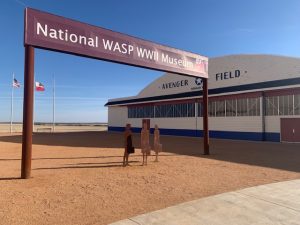
The WASP museum in Sweetwater, Texas, honoring women pilots from World War Two
Sweetwater is also home to the National WASP World War II Museum. It’s located at Avenger Field, where members of the Women Airforce Service Pilots were trained to fly in 1943 and 1944 by famed aviator Jacqueline Cochran. They were the first women to fly military aircraft. During the war, more than 1,000 of these female pilots flew more than 60 million miles, mostly ferrying planes from factories to shipping points as well as flying damaged planes back to bases. In all, 38 of the female pilots were killed in action.
We stopped by the museum on a Sunday morning in March 2022, but it unfortunately wasn’t open until 1 p.m. We had to settle for admiring the two nice hangars and beautiful sculpture out front as well as peeking in through the glass doors at the exhibits inside. We could see a quote on the wall from WASP pilot Cornelia Fort: “I am grateful that my one talent, flying, was useful to my country.”
The town also has the 750-seat Sweetwater Municipal Auditorium, which was built in 1926. Over the decades, the performers have included John Philip Sousa, Fred and Adele Astaire, and even Elvis Presley, who appeared there not once but twice in 1955.
Finally, the Sweetwater Jaycees are hosts of the world’s largest rattlesnake round-up every March. The events include the rattlesnake parade, a snake eating contest and a Miss Snake Charmer Pageant. The round-up has received some criticism for the unlimited of snakes hunters are allowed to snatch as well as some of the methods used to lure the reptiles from their underground homes.
A lot to contemplate in this town in the middle of Texas.
Tomorrow, we finish off the first week of our journey by traveling through what’s known as Hill Country in Texas for some peaches and wildflowers before ending up at one of the premier cities in the Lone Star State.


